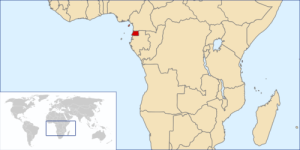1936 uprising in Spanish Guinea facts for kids
Quick facts for kids 1936 uprising in Spanish Guinea |
|||||||
|---|---|---|---|---|---|---|---|
| Part of the Spanish Civil War | |||||||
 Location of Spanish Guinea in central Africa. |
|||||||
|
|||||||
| Belligerents | |||||||
| Commanders and leaders | |||||||
The 1936 uprising in Spanish Guinea was a fight for control of Spanish Guinea. This happened during the Spanish Civil War. It was fought between the Republicans and Nationalists. The conflict took place from September to October 1936. The Nationalists first took control of Fernando Poo island on September 19. They later took over the rest of the colony after more troops arrived in October.
History of Spanish Guinea
The Spanish Empire created the colony of Spanish Guinea in 1778. This happened after the Treaty of El Pardo with Portugal. For a long time, Portuguese slave traders mostly controlled the area. Then, in 1858, Carlos Chacón became its first official governor.
During the time known as the Scramble for Africa, Spain lost parts of its land in the Gulf of Guinea to France and Germany. Spain also suffered a big loss in the Spanish–American War of 1898. This made Spanish Guinea even more important as an overseas territory. People started to use the colony's natural resources more. Missionaries built churches and schools. In 1908, the Colonial Guard of Spanish Guinea was formed to protect the new settlers.
When the Second Spanish Republic was formed, new rules were made for the colony. The government wanted to increase Guinea's economic output. They also limited the power of Catholic missionaries and the rights of the native people.
On July 13, 1936, a Spanish politician named José Calvo Sotelo was killed in Madrid. This led to a nationalist takeover attempt four days later. The start of the civil war in Spain caused problems in the colony. Supporters of the left-wing Popular Front fought against the "clericales." These "clericales" supported the Nationalist rebels and the Catholic church. Tensions grew during the summer. Bank accounts were frozen, and supplies stopped reaching the colony.
The Conflict Begins
On September 19, 1936, a leader of the Colonial Guard, lieutenant colonel Luis Serrano Maranges, started an uprising. He took control of Fernando Poo island. He removed the Republican Governor-General Sanchez Guerra without a fight. Following orders from Francisco Franco, Serrano became the new governor. He declared that the colony was at war.
The Vice-Governor, Miguel Hernandez Porcel, was in Bata. He refused to accept Serrano's control. On September 23, supporters of the Nationalists on the mainland formed a group. They marched towards Bata to support Serrano. Porcel sent his own troops to stop them.
The two groups met near the Ekuku river. They clashed after shouting their different slogans. Two local soldiers were killed in the fight. The Republicans won this battle. The Nationalist leaders on the mainland were sent away to French Congo. Many of them later went to Fernando Poo. This split the colony: Fernando Poo supported the Nationalists, and Río Muni supported the Republicans.
Nationalist Victory
The Republicans in Río Muni became cut off from their allies. Their only ship, the Fernando Poo, was being used as a prison for Catholic missionaries and nuns.
In October, a Nationalist ship called the Ciudad de Mahon arrived at Fernando Poo. This ship had guns and carried Moroccan Nationalist troops from the Canary Islands. Serrano took control of this ship. He used it to attack Bata. The ship also hit the Fernando Poo, killing three clergymen and a civilian who were prisoners on board. The Republican fighters quickly left the sinking ship. Troops from the Ciudad de Mahon then boarded the damaged ship before it sank the next day.
The Nationalist troops landed in Bata. They quickly took control of Río Muni. Most Republicans fled to French Congo. Some who stayed were executed, while others were sent to the Canary Islands in November.
Aftermath
The conflict, along with problems in global trade during World War II, caused shortages in the colony. There was not enough food or medicine, and prices went up a lot.
After taking control, the Nationalists changed the names of local areas to Spanish names. They also made Fernando Poo and Río Muni legally part of Spain. Over time, they gave more rights to the native population. The idea of nationalism grew among the first generation of these newly empowered native people. These individuals later led the colony to become independent as Equatorial Guinea in 1968.
See also
In Spanish: Sublevación militar de 1936 en la Guinea Española para niños

